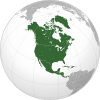Geography of Martinique
This article was imported from the CIA's World Factbook. |
Nickname: Island of Flowers | |
|---|---|
 | |
| Geography | |
| Location | Caribbean Sea |
| Coordinates | 14°40′N 61°00′W / 14.667°N 61.000°W |
| Archipelago | Windward Islands |
| Area | 1,060 km2 (410 sq mi) |
| Coastline | 350 km (217 mi) |
| Highest elevation | 1,397 m (4583 ft) |
| Administration | |
France | |
| Demographics | |
| Population | 429,510 |
| Pop. density | 405.2/km2 (1049.5/sq mi) |
Climate
This section is empty. You can help by adding to it. (July 2010) |
Martinique has a warm, stable climate that only varies 5 degrees Fahrenheit all year round. Trade winds blow refreshing breezes from the northeast.
Statistics
Location: Caribbean, island in the Caribbean Sea, north of Trinidad and Tobago
Geographic coordinates: 14°40′N 61°00′W / 14.667°N 61.000°W
Map references: Central America and the Caribbean
Area:
total:
1,100 km²
land:
1,060 km²
water:
40 km²
Area - comparative: slightly more than six times the size of Washington, D.C.
Land boundaries: 0 km
Coastline: 350 km
Maritime claims:
exclusive economic zone:
200 nmi (370.4 km; 230.2 mi)
territorial sea:
12 nmi (22.2 km; 13.8 mi)
Climate: tropical; moderated by trade winds; rainy season (June to October); vulnerable to devastating cyclones (hurricanes) every eight years on average; average temperature 17.3 degrees Celsius; humid
Terrain: mountainous with indented coastline; dormant volcano
Elevation extremes:
lowest point:
Caribbean Sea 0 m
highest point:
Montagne Pelee 1,397 m
Natural resources: coastal scenery and beaches, cultivable land
Land use:
arable land:
8%
permanent crops:
8%
permanent pastures:
17%
forests and woodland:
44%
other:
23% (1993 est.)
Irrigated land: 40 km² (1993 est.)
Natural hazards: hurricanes, flooding, and volcanic activity (an average of one major natural disaster every five years)
Environment - current issues: NA
Population:429,510

